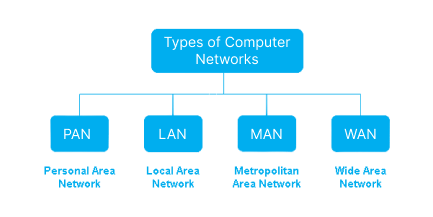Introduction to Computer Networking: Understanding the Fundamentals
Table of Contents

- jaro education
- 30, April 2024
- 10:00 am
A computer network is a sophisticated system that allows different devices, like your phone or a powerful server, to seamlessly share information. These devices are linked together through physical wires, like fiber optics, or wirelessly.
The story of computer networking goes back to the late 1960s with ARPANET, a groundbreaking network funded by the U.S. Department of Defense. Originally designed to help government researchers share information in a time when computers were bulky and hard to move, ARPANET laid the groundwork for today’s interconnected world. Fast forward to now, and the internet reigns as a global network connecting billions of devices worldwide. Whether it’s monitoring traffic in cities or collaborating remotely using tools like Google Drive, computer networks play a vital role in communication and sharing information across various sectors.
Computer networking covers a wide range of ideas and practices, blending elements of computer science, engineering, and telecommunications. It deals with everything from planning and building networks to keeping them secure. Whether it’s setting up secure connections for remote work or making sure data moves smoothly for real-time applications, computer networking is the foundation of our digital society.
In this blog, we’ll explore the basics of computer networking, looking at its main parts, principles, and how it’s used. Understanding this essential technology better will guide readers in navigating our interconnected world with confidence and ease.
What is Computer Networking?
A computer network refers to a collection of computers that share resources, which can be located on or provided by network nodes. These computers utilize standard communication protocols across digital connections to interact with one another. These connections are established using telecommunication network technologies, including wired, optical, and wireless radio-frequency methods, and can be organized into various network topologies.
The components of a computer network can include personal computers, servers, networking equipment, and other specialized or general-purpose devices. Unique network addresses identify them and may also have hostnames. Hostnames are used as recognizable labels for the nodes and are typically set during the initial configuration, with minimal changes afterward. Network addresses are essential for locating and distinguishing nodes, especially through communication protocols like the Internet Protocol (IP).
Computer networks facilitate a wide range of applications and services, such as accessing the World Wide Web, streaming digital media, utilizing shared servers for applications and storage, connecting to printers and fax machines, and using email and instant messaging platforms.
Component of Computer Networking
Network Interface Card (NIC)
A Network Interface Card (NIC) is a crucial device that enables computers to communicate with other devices on a network. This card contains hardware addresses, which are utilized by the data-link layer protocol to identify systems within the network and ensure that data is transmitted to the correct destination.
There are two primary types of NIC: wireless NIC and wired NIC.
- Wireless NIC: Modern laptops commonly utilize wireless NICs, establishing connections through antennas that leverage radio wave technology.
- Wired NIC: Wired NICs use cables to transfer data across the network medium.
Hub
A hub serves as a central device that distributes network connections to multiple devices. When a computer requests information from another computer, it sends the request to the hub, which then disseminates this request to all interconnected computers.
Switches
Switches are networking devices that organize devices within a network to facilitate data transfer. Unlike hubs, switches do not broadcast messages across the entire network; instead, they send messages directly to the intended destination device. This targeted approach enhances network efficiency by enabling direct communication from the source to the destination.
Cables and Connectors
A cable functions as a transmission medium for communication signals. There are three primary types of cables:
- Twisted Pair Cable: This type of cable operates at high speeds, transmitting data at rates exceeding 1Gbps.
- Coaxial Cable: Resembling a TV installation cable, coaxial cable is more costly than twisted pair cable but offers superior data transmission speeds.
- Fiber Optic Cable: Utilizing light beams for data transmission, fiber optic cable delivers exceptionally high-speed communication. It is the most expensive option and is typically utilized at governmental levels.
Router
A router serves as a device that links a local area network (LAN) to the internet. Its primary function is to interconnect separate networks or enable internet connectivity for multiple computers.
Modem
A modem connects a computer and the internet via an existing telephone line. Unlike integrated components on a computer motherboard, a modem is a separate device that connects to a PC slot on the motherboard.
Major Advantages Computer Networking
- Communication Efficiency: Networking technology facilitates rapid and effective communication. For instance, it enables video conferencing, email messaging, and other forms of online communication, making it an invaluable tool for sharing knowledge and ideas.
- Seamless File Sharing: File sharing stands out as a significant benefit of computer networks, allowing users to easily share files with one another.
- Simplified Backup and Rollback: Storing files on a centrally located main server simplifies the backup process, making it easy to secure important data.
- Centralized Software and Hardware Access: Installing applications on the main server enables users to access them centrally, eliminating the need for individual installations on every machine. Additionally, hardware resources can be shared across the network.
- Enhanced Security Measures: Networks ensure security by granting appropriate user access to specific files and applications, bolstering overall data protection.
- Scalability and Considerations: Scalability refers to the ability to expand a network by adding new components. While this enhances network capabilities, it can reduce connection and data transmission speeds, leading to potential errors. Employing routing or switching devices can mitigate these challenges.
- Reliable Data Communication: In the event of hardware failures, computer networks can seamlessly switch to alternative data communication sources, ensuring uninterrupted connectivity.
If you are interested in computer science and want to enhance your knowledge and become a modern tech maestro, in that case, you should explore the Online M.Sc.(Computer Applications) from Symbiosis School for Online and Digital Learning (SSODL) designed for tech graduates aiming to become forward-thinking technology leaders in today’s dynamic landscape.
Types of Computer Networking Architecture
Computer networking architecture is the structured arrangement of software, hardware, protocols, and communication media for data transmission, encompassing physical and logical aspects. It defines how computers are structured and how tasks are distributed among them.
Computer networks are broadly categorized into two main architectures:
- Client-Server Architecture: This architecture involves nodes that can function as either servers or clients. In a client-server setup, the server node manages and oversees the behavior of client nodes.
- Peer-to-Peer Architecture (P2P): In P2P architecture, there is no central server concept. Instead, each device has the autonomy to act as either a client or a server as needed, allowing for decentralized communication and resource sharing.
However, modern networking is no longer just about connecting devices; it has become essential for the digital transformation of organizations. Here are different types of network architectures that have been developed to meet these changing needs:
- Software-Defined Networking (SDN): This kind of network adapts to the digital age by being more flexible, automated, and open. SDN controls traffic routing through software, allowing the network to quickly adjust to new conditions.
- Intent-Based Networking (IBN): IBN improves upon SDN by adding agility and automating operations. It aligns the network with specific goals by analyzing performance, ensuring strong security, integrating with business processes, and resolving issues efficiently.
- Virtualized Networks: These networks divide the physical infrastructure into multiple virtual networks. Each virtual network can be adjusted for security, quality of service (QoS), and other needs.
- Controller-Based Networking: Network controllers are key for scaling and securing networks. They automate tasks, monitor devices for performance and security, simplify operations, and help businesses adapt to changes.
- Multidomain Integrations: Large companies may have separate networks for different parts of their operations. These networks communicate through controllers, ensuring that they work together smoothly to achieve business goals.
Types of Computer Networking
Computer networks can be classified based on their scale. There are four primary types of computer networks:
- LAN (Local Area Network)
- PAN (Personal Area Network)
- MAN (Metropolitan Area Network)
- WAN (Wide Area Network)

*prepbytes.com
LAN(Local Area Network)
A Local Area Network (LAN) is a group of computers connected in a small area like a building or office, allowing them to communicate with each other easily. LANs are commonly used to connect personal computers using cables like twisted pairs or coaxial cables. They are cost-effective because they use affordable hardware such as hubs, network adapters, and ethernet cables. LANs transfer data quickly, providing fast connectivity, and are also known for their strong security features.
PAN (Personal Area Network)
A Personal Area Network (PAN) is a network made for an individual’s space, usually within 10 meters. It’s mainly used to link personal devices and is called a Personal Area Network. Research scientist Thomas Zimmerman first introduced this idea. A PAN usually covers about 30 feet and is set up using personal devices like laptops, mobile phones, media players, and gaming consoles such as PlayStations.
MAN (Metropolitan Area Network)
A Metropolitan Area Network (MAN) is a network that connects multiple Local Area Networks (LANs) across a larger geographic area, forming a larger network. Government agencies commonly use MANs to connect with citizens and private industries. In a MAN, different LANs are linked together through telephone exchange lines. Some of the most commonly used protocols in MANs include RS-232, Frame Relay, ATM, ISDN, OC-3, ADSL, and others. MANs have a wider coverage range compared to Local Area Networks (LANs).
WAN (Wide Area Network)
A Wide Area Network (WAN) is a network that covers a large geographical area, like states or countries. It’s much larger than a Local Area Network (LAN). Unlike LANs, WANs aren’t confined to one place but connect over long distances using telephone lines, fiber optic cables, or satellite links. The internet is an example of a massive WAN that spans the globe. WANs find extensive use in business, government, and education sectors due to their ability to connect distant locations efficiently.
Transmission Model in Computer Networking
Transmission mode in computer networking is how data is sent from one device to another, also called the communication mode. Each communication channel has a direction, determined by the transmission media, so transmission mode is also called directional mode. It’s defined in the physical layer and categorized into three types:
- Simplex mode,
- Half-duplex mode
- Full-duplex
Simplex mode
In Simplex mode, communication flows in only one direction, meaning the data moves in one direction only. A device can either send data without receiving it, or receive data without sending it. This mode isn’t very common because most communications require a two-way exchange of data. Simplex mode is used in business scenarios like sales where no response is needed. For instance, a radio station operates in simplex mode as it broadcasts signals to listeners without allowing them to transmit back. Examples of simplex mode include keyboards, which only accept input from users, and monitors, which solely display data on screens. The main advantage of simplex mode is that it allows the full capacity of the communication channel to be utilized during transmission.
Half-duplex mode
In a half-duplex channel, the direction of data transmission can be switched back and forth, meaning a station can both send and receive data. However, messages flow in only one direction at a time, not simultaneously. This setup allows the entire bandwidth of the communication channel to be used in one direction at a time. In half-duplex mode, error detection is possible, and if an error occurs, the receiver asks the sender to resend the data. A common example of half-duplex mode is a walkie-talkie. In a walkie-talkie, one person speaks while the other listens, and then they switch roles after a pause. If both parties speak simultaneously, it creates a distorted sound that is difficult to understand.
Full Duplex
In Full Duplex mode, communication goes both ways, meaning data flows in both directions. This allows both stations to send and receive messages at the same time. The full-duplex mode uses two simplex channels, with one channel for traffic in one direction and another channel for traffic in the opposite direction. It’s the fastest mode of communication between devices. A common example of full-duplex mode is a telephone network, where two people can talk and listen simultaneously over the same line.
Topology in Computer Networking
Network topology is how nodes and connections are set up in a network, both in terms of physical layout and logical organization. Nodes usually consist of devices such as switches, routers, and software with similar capabilities. These arrangements are often shown graphically.
Network topologies help administrators understand how networks are structured and how traffic moves through them. This understanding helps them determine the best places to put each node and the most efficient paths for data to travel. Organizations can find and fix issues faster with a clear and carefully planned network topology, making data transfers smoother and more efficient. There are six main types of network topology: Bus Topology, Ring Topology, Tree Topology, Star Topology, Mesh Topology, and Hybrid Topology.

*networksimulationtools.com
Bus Topology
The bus topology is a setup where all stations are connected through one cable called a backbone cable. Nodes can connect to the backbone cable either directly or through drop cables. When a node sends a message, it goes out to all stations on the network, regardless of who it’s meant for. This topology is often used in 802.3 (Ethernet) and 802.4 standard networks due to its simplicity. It’s easier to configure compared to other setups. The backbone cable acts like a single lane, broadcasting messages to all stations. The most common access method for bus topologies is CSMA (Carrier Sense Multiple Access)
Ring Topology
A ring topology is similar to a bus topology, except that its ends are connected. In this setup, when a node gets a message from the previous computer, it forwards it to the next node. This creates a unidirectional flow of data in a continuous loop, also called an endless loop, without any terminated ends since each node connects to another without a stopping point. In a ring topology, data circulates in a clockwise direction, and the primary access method used is token passing, which is quite common in this type of network arrangement.
Star topology
A star topology is a network setup where each device is connected to a central hub, switch, or computer. The central device, often called a server, manages the network, while the devices connected to it are known as clients. Coaxial or RJ-45 cables are typically used for these connections. Hubs or switches serve as the main connection points in a physical star topology. This type of setup is widely used and considered one of the most popular network topologies.
Tree Topology
Tree topology is a mix of bus and star topologies. In this setup, computers are linked in a hierarchy. The highest node is called the root node, and all other nodes stem from it. Data transmission between nodes follows a single path, creating a parent-child arrangement.
Mesh Topology
Mesh technology is a network arrangement where computers are connected to each other through multiple redundant connections, creating several pathways between computers. Unlike other network types, such as those with switches, hubs, or central computers, mesh networks do not rely on a central point of communication. An example of a mesh network is the Internet itself. Mesh topology finds significant use in WAN setups where communication failures are a critical issue and is also commonly employed in wireless networks.
This type of network can be created using a specific formula:
the number of cables needed = (n*(n-1))/2,
Where ‘n’ represents the number of nodes in the network.
Hybrid Topology
Hybrid topology refers to combining different types of network structures. It involves linking various links and nodes to facilitate data transfer. When two or more diverse topologies are merged, a hybrid topology is created. However, connecting similar topologies does not create a Hybrid topology. For instance, if one branch of ICICI Bank uses a ring topology and another branch uses a bus topology, connecting these two branches would create a Hybrid topology.
Conclusion
A successful computer network goes beyond just technical setup; it’s a vital tool that boosts productivity, ensures security, and encourages innovation while keeping costs down. It’s crucial to have a strong design and implementation process that matches the business’s needs and goals. Although setting up a computer network may seem purely technical, it requires active involvement from the business side, especially in the beginning.
Moreover, managing a computer network effectively means adapting workflows, embracing new technologies, and staying flexible to meet changing business and tech demands. Organizations can build networks that drive growth and resilience in today’s fast-paced digital world by combining technical know-how with business understanding.









